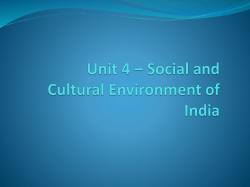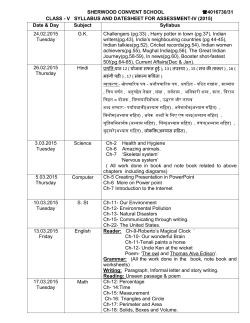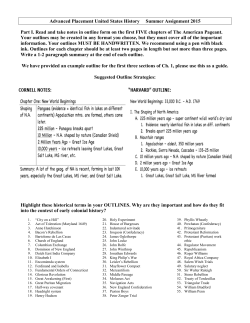
significance of modi`s forthcoming visit to china
CAPS INFOCUS 23 APR 2015 www.capsindia.org SIGNIFICANCE OF MODI’S FORTHCOMING VISIT TO CHINA SHAHELI DAS Research Associate, CAPS The dynamism of the Sino-Indian relationship maybe defined as an ambivalent mixture of mutual rivalry for the quest for power in overlapping spheres of influence and a yearning for recognition as a significant global power. Inspite of a shift in perception from one of uneasy coexistence to one of peaceful coexistence, areas of tension have still kept the two Asian giants trapped in a protracted contest.i It is in this context that the significance of Shri Narendra Modi’s first visit to Beijing after his appointment to office as the Indian Prime Minister must be viewed. The China factor in India’s foreign policy Inspite of a distinguished peaceful civilizational co-existence and an era of ‘Hindi-Chini Bhai Bhai’, China and India have over the years developed a sense of mutual antagonism due to a host of factors. The Sino-Indian border clash of 1962, repeated Chinese border incursions, its claim over the sovereignty of Arunachal Pradesh, endeavour to build a road through Aksai Chin, support to Mizo and Naga insurgents and the Naxalites together with China’s stand on the Jammu and Kashmir issue and its ‘all weather friendship’ with Pakistan have led to the development of a China threat perception, owing to the threat that they pose to India’s national security.ii It is this decades old feeling of suspicion and threat intermingled with the present atmosphere of benevolence and a prospect for a thriving future that defines the Sino-Indian bilateral relations today. CAPS INFOCUS 23 APR 2015 www.capsindia.org The Modi-Xi Era With the ascendency of new leadership to power on both sides, there appears to be an opening up of a new chapter in Sino-Indian diplomatic relationship. The commonality in posture of the two leaders in terms of their foreign policy approach, have brought the two Asian giants on a common ground, after many years. Both leaders identify maintenance of good neighbourly relations and the importance of commercial diplomacy as the underlying principle to the country’s foreign policy framework, as the key to success. Significance of the visit The forthcoming visit of Prime Minister Modi to Beijing in May 2015 holds great significance not only in terms of politics but also from the strategic and security perspective of India’s national security. The visit of Mr Modi to Beijing was announced only a week after he received the US President, Mr. Barack Obama as the Chief Guest of India’s Republic Day. The announcement of the visit itself had heavy implications. It upturned theories that proposed an Indian inclination towards the US and showcased the continuance of Non-Alignment Policy as an essential feature of India’s foreign policy. Further, the emphasis on Prime Minister Modi’s visit being scheduled within the stipulated date of his first anniversary in the government, illustrates the importance and priority that India tenders to China. Considering the fact that India lives in a troubled neighbourhood, it is imperative for her to maintain relations of mutual goodwill with her neighbours. The presence of China in Southeast Asia is viewed by India as a threat, is a reality today. To add to it, China’s attempt to camouflage its real motive behind its engagement with Pakistan and Sri Lanka is well known to the Indian leadership. The onus to develop the Gwadar and Hambantota Port in Pakistan and Sri Lanka respectively as commercial hubs is defined by China as a measure to fulfil its economic needs. However, owing to instances in the recent past such as the presence of a Chinese naval submarine in Colombo in 2014, India’s threat perception has got reinforced. India perceives that the Chinese presence in these two ports go way beyond the mere fulfilment of economic objectives and has strategic and security implications. CAPS INFOCUS 23 APR 2015 www.capsindia.org India believes that through the Gwadar port China seeks to extend its military clout to the Arabian Sea and the Persian Gulf, and gain access to the Indian Ocean through the Hambantota port. The Indian Ocean is critical to India as 70% of its liquefied energy resources pass through this area. Therefore Chinese control over the region would lead to a grave situation for Indian economy. It is in view of these concerns that the Indian government has decided to revise its Indian Ocean strategy and consequently strengthen the Indian Ocean Rim Association. To this end, Indian Foreign Minister Sushma Swaraj had recently visited Maldives and UAE followed by PM Modi’s three nation visit to Sri Lanka, Seychelles and Maldives. In this context Modi’s forthcoming visit would be pathfinder towards development of an atmosphere of mutual co-existence in Asia and minimise China’s interest in the development of naval ports in and around India. China too views this visit as significant. Inspite of China’s rhetoric of its “all weather friendship” with Pakistan, it must be realised that China utilises it as a mere economic and military corridor to expand its clout in Asia and in the international sphere. Further, the past and present moment which seems to favour the Sino-Pakistan relations, is not an apt guarantor of future course of action. Chances seem bright of China’s inclination towards India owing to India’s GDP growth rate of 7.5 % which is way ahead of Pakistan’s GDP growth rate of 4.14%.iii This calls for China to have better gains from its engagement with India than with Pakistan. India on its part, seeks to derive more funds and investments for developing industrial parks and smart cities. Thus the visit may witness a spill over effect of political goodwill into the economic realm, in terms of investment in the ‘Make in India’ project and other infrastructure development projects together with the signing of several Memorandum of Understanding (MoU) promoting trade and commerce between the two parties. The border dispute which remains a major irritant in the Sino-Indian relations, would also find considerable attention during the visit . The two countries share a 3380km border with two main disputed territories: Arunachal Pradesh and Aksai Chin. Attempts to seek a long-term solution has not seen a constructive end, due to repeated Chinese border incursions. The recent episode of border incursions took CAPS INFOCUS 23 APR 2015 www.capsindia.org place in April 2013, when the People’s Liberation Army (PLA) troops camped on the Indian side of the Line of Actual Control (LoAC) for almost three weeks. The Chinese side, which holds Arunachal Pradesh as an extension of South Tibet, has constantly protested against the official tours undertaken by officials working for the Government of India and most recently against the visit of PM Modi to the region. They claim it to be a violation of the agreement of Sino-Indian border dispute. Although several diplomatic agreements and talks have been concluded on earlier occasions such as the Border Defence Cooperation Agreement (2013) and the 18th Special Representative’ Meeting on ChinaIndia boundary question (2015) yet no substantive breakthrough could be identified in this regard. Mr. Modi’s maiden visit to China is highly significant in terms of resolution of the border dispute. Both President Xi and Prime Minister Modi have expressed considerable seriousness about enunciating dialogue on this front. There seems to be a good scope for revision in the agreements on the border dispute considering the shared vision of both leaders to view economic growth as an imperative to their country’s development. A peaceful border would facilitate booming trade whereby India could benefit from China’s capital and exports and Beijing could benefit from Indian market and proficiency in technology . Further, peace on the regional front would enable both countries to escalate their domestic economic development as well as engage in an uninhibited opportunity to integrate with the world economy. Finally the visit may have an implication in the international sphere as well. In view of the visible bonhomie between China and Russia owing to the imposition of Western sanctions on Russia post the Ukraine crisis in 2013, this visit may be a step forward towards the creation of a coalition between ChinaRussia-India. The three countries which are already members of the BRICS have also engaged with each other through several projects initiated by China, such as the ‘One Belt One Road’ and the Asian Investment Infrastructure Bank. The core issues that have acted as a common ground bringing the three countries together is the desire to shift out of the shadow of US hegemony and build a multipolar world. CAPS INFOCUS 23 APR 2015 www.capsindia.org Conclusion The visit of Prime Minister Modi to Beijing comes at an opportune moment in the Sino-Indian relationship. On the eve of the 65th year of the establishment of diplomatic ties, the two Asian giants seem to co-exist with a sentiment of mutual goodwill towards each other. The agreement between the two sides, upon the package plan of Kailash Manasarovar Yatra through the Nathula Pass to the Tibet Autonomous Region and China’s endeavour to link the ‘Belt and Road’ project with India’s ‘Mausam’ and ‘Spice Route’ Projects demonstrate such state of affairs. In such an atmosphere of amity, chances seem bright of a ‘winwin’ outcome to the pressing issues that de-track the trajectory of Sino-Indian relations and a step forward towards the opening up of the “golden chapter” in Sino-Indian bonhomie. **** (Disclaimer: The views and opinions expressed in this article are those of the author and do not necessarily reflect the position of the Centre for Air Power Studies [CAPS]) i Jonathan Holslag, “ Sino-‐Indian Rivalry in an Era of Globalization,” China + India Prospects for Peace ( New York: Columbia University Press, 2008), p.1 ii Giri Deshingkar, “ India-‐ China: The Security Dimension,” Security and Science in China and India ( New Delhi: Shivam Offset Press, 2005), p. 25 iii India’s GDP Grow Faster Than China’s in Q4 Link: http://www.tradingeconomics.com/india/gdp-‐growth-‐annual Page Designed By: Kriti Singh, AF, CAPS
© Copyright 2025
















